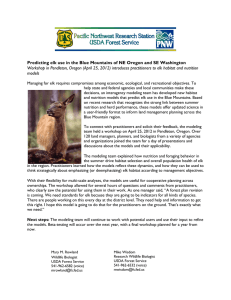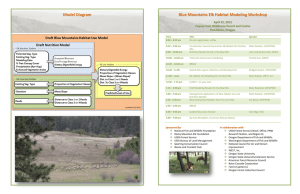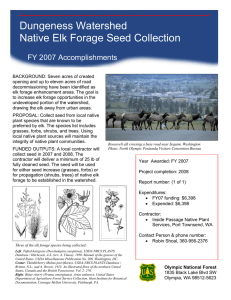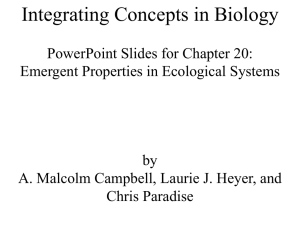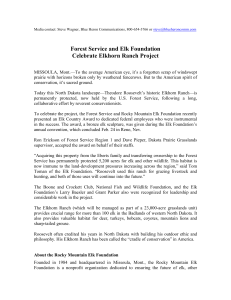Models for a new century Elk have multi-million dollar
advertisement
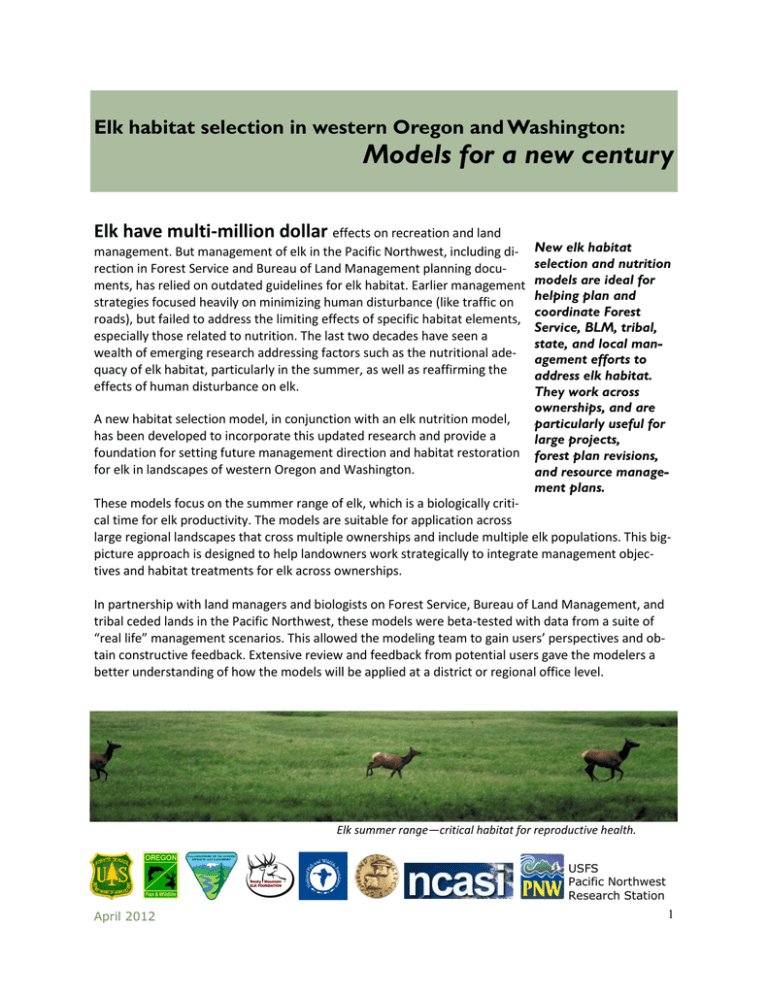
Elk habitat selection in western Oregon and Washington: Models for a new century Elk have multi-million dollar effects on recreation and land management. But management of elk in the Pacific Northwest, including direction in Forest Service and Bureau of Land Management planning documents, has relied on outdated guidelines for elk habitat. Earlier management strategies focused heavily on minimizing human disturbance (like traffic on roads), but failed to address the limiting effects of specific habitat elements, especially those related to nutrition. The last two decades have seen a wealth of emerging research addressing factors such as the nutritional adequacy of elk habitat, particularly in the summer, as well as reaffirming the effects of human disturbance on elk. A new habitat selection model, in conjunction with an elk nutrition model, has been developed to incorporate this updated research and provide a foundation for setting future management direction and habitat restoration for elk in landscapes of western Oregon and Washington. New elk habitat selection and nutrition models are ideal for helping plan and coordinate Forest Service, BLM, tribal, state, and local management efforts to address elk habitat. They work across ownerships, and are particularly useful for large projects, forest plan revisions, and resource management plans. These models focus on the summer range of elk, which is a biologically critical time for elk productivity. The models are suitable for application across large regional landscapes that cross multiple ownerships and include multiple elk populations. This bigpicture approach is designed to help landowners work strategically to integrate management objectives and habitat treatments for elk across ownerships. In partnership with land managers and biologists on Forest Service, Bureau of Land Management, and tribal ceded lands in the Pacific Northwest, these models were beta-tested with data from a suite of “real life” management scenarios. This allowed the modeling team to gain users’ perspectives and obtain constructive feedback. Extensive review and feedback from potential users gave the modelers a better understanding of how the models will be applied at a district or regional office level. Elk summer range—critical habitat for reproductive health. USFS Pacific Northwest Research Station April 2012 1 What have we learned about elk populations and habitat? The needs of elk are compatible with active silvicultural management. However, although elk benefit substantially from a variety of management practices that reduce overstory cover, use of the resulting forage base depends on availability of nearby cover and on managing human disturbance, for example through seasonal road closures. In general, the lower the canopy closure and the higher the elevation, the greater the abundance of high quality forage species and dietary digestible energy (DDE). Digestible protein also tends to follow this pattern. DDE relates directly to animal performance. Herds with summer deficiencies in DDE may have low body fat and reduced pregnancy rates. Nutritional resources for elk are relatively poor in the Coast Range and many areas in the Cascades. Even with clearcuts, forage quality is often below maintenance level for lactating elk in these areas. “Elk really do know what they’re doing out there on the landscape,” says model developer Mike Wisdom. “If they’re not spending time in the most nutritionally dense areas, they’re very close to those areas.” During summer in western Oregon and Washington, elk select gentle slopes close to cover-forage edges, but away from open roads; consideration of these preferences in planning management activities on public and private lands that support elk is necessary to maximize benWhat does the habitat efits to elk. model require? The models are explicitly designed to evaluate summer range condiThe team found that tions because this is the time that substantially affects year-round ani- the model that mal performance. For example, summer range conditions directly afperformed best in affect pregnancy rates and body fat levels of elk entering winter. Con- validation tests was sequently, evaluation and management of summer range conditions is based on four habitat covariates: considered essential to year-round management of healthy elk herds. distance to open public road dietary digestible energy (DDE) distance to coverforage edge slope 2 What can the habitat model do? The model characterizes elk use patterns across landscapes. It can help set goals for changing elk use in certain areas, and help assess how to get more “bang for your buck” with management prescriptions. It can also show the consequences of NOT improving habitat. Because the model is regional in scale, it facilitates an “all lands” approach that can help encourage and inform dialogue among different ownerships and agencies. How does it work? The habitat model has two main components: a nutrition submodel that ranks areas across landscapes according to their nutritional value for foraging elk, and a habitat selection model that incorporates nutrition with other covariates to rank areas according to predicted level of use by elk. Users can compare different management scenarios: for example, using the Forest Vegetation Simulator, you could remove canopy cover in units across a management landscape and then estimate dietary digestible energy (DDE) at specific time intervals to make predictions of elk use. If management speeds up or re“The model presents a picture tards vegetation succession, the model will reflect that. of the average behavior of the average elk across a whole region,” explains model developer Ryan Nielson. An analysis on the Mt. Baker-Snoqualmie National Forest helped the Muckleshoot Indian Tribe evaluate alternative management scenarios to benefit tribal treaty resources. This map shows the predicted level of elk use on the study area under existing conditions. 3 Frequently asked questions What is the minimumsized area for model application? The habitat model is designed for application at the same spatial extents at which it was developed and validated. In general, the minimum size of area is approximately 25,000 acres (10,000 hectares). Can these models be used for winter habitat? Movement corridors? Hunting seasons? No. The telemetry data used to fit the models were filtered for summer (June – August) months only, when the females are trying to put on body fat—a key component of overall productivity. These models may not be accurate in the hunting season, or for spring or winter seasons. Can the models be used in southwest Oregon? Not yet. Differences in vegetation and nutritional conditions between southwest Oregon and further north may be substantial. But the team collected new vegetation and elk nutritional data in 2011 and plans to develop a new nutrition model for SW Oregon that can be incorporated into the habitat model and then applied in SW Oregon. If we want to draw elk away from private land, what forage species should we reintroduce? Forage selection data from elk grazing experiments can help identify which species to avoid and which are palatable to elk. The model, however, relies on groups of species, not individual species, based on their palatability. What if active management for elk is not feasible because you have owl habitat? Management of public lands has become a complex balance between sometimes competing demands. Regardless of the management objectives on a given piece of forest, this model can still provide information about impacts of different land uses on elk populations and help practitioners weigh possible alternatives. As one land manager said, “Having these nutrition maps could really help us from an administrative standpoint because they justify creating openings.” Even if forest canopy cover cannot be manipulated, targeted road management can still improve elk habitat quality. Can fire regime The model is “static” in that it evaluates landscape conditions for a given considerations be added point in time. However, any landscape conditions can be simulated based to the model? on fire or other disturbance regimes, with the use of a variety of commonly available software packages (e.g., VDDT models). Projections from these landscape simulation models can then be used to evaluate future habitat conditions for elk, by using results from the simulations as covariates in the elk habitat model. 4 Frequently asked questions Is managing road access still a good idea? Yes. For elk to fully benefit from knowledge gained through the modeling process about elk habitat choices, active road management is necessary, and can offer benefits when changes in forest cover to benefit elk are infeasible. Can this model capture No. The model works at a broader scale than most individual treatments on the impact of treatments public land. For example, the model resolution would not capture the imon local habitat quality? pact of management prescriptions such as variable density thinning (“skips and gaps”) implemented on 1/2-acre plots. What the model can be helpful for is laying out landscape-scale habitat enhancement scenarios such as determining what general areas would yield the most promising results from silviculture activities or road and trail management. Another value of the model is that it can make explicit the negative consequences of certain management constraints on elk habitat. Do model results mean we should not manage for elk habitat in the Coast Range? The regional model shows consistently poor nutritional conditions for elk in the Coast Range, and body fat measurements and pregnancy rates back this up. The nutritional needs of lactating elk in summer may not be fully met in the Coast Range, even with forest management activities. Nonetheless, early seral habitats are much better for elk than large tracts of closed-canopy coniferous forests. All in all, our data clearly indicate that improvements through active management should benefit elk, even in the Coast Range. What is the definition of forage area (as used in the distance-to-edge calculations)? In the habitat model, stands with trees less than 2 meters tall and canopy cover less than 40 percent are considered “forage” areas. If this threshold were lower, areas defined as forage would be substantially more shortlived. For example, many areas in western Oregon and Washington achieve overstory canopy cover of more than 20 percent within five years of timber harvest. Our analyses suggest that elk are responding to a cover-forage edge defined by the 40 percent canopy cover threshold. Information products available Maps GIS files Peer-reviewed publications User guide (USFS General Technical Report) 5 Model caveats Solutions Models are not applicable to SW Oregon. The SW Oregon model is now being developed, using field data on elk nutrition collected in the summer of 2011. Training can quickly teach users the basics of applying the models in their home landscapes. GIS toolboxes for these processes will be provided to potential users. Other delivery methods are also being explored. Models require significant GIS experience to run. Models do not work well on small projects (<25,000 acres). Vegetation data currently used to model elk habitats in western OR and WA are from 2006. For some forested land, it is difficult to move forage condition beyond marginal nutritional conditions due to current restraints on forest management under the Northwest Forest Plan. Base vegetation layers need to be updated annually to account for disturbances or habitat alterations. Users can evaluate multiple smaller projects across a landscape with the model. Updated vegetation data can be used, but may need to be modified manually to work with the models. Even marginal conditions provide documented improvements in animal performance compared to poor conditions, and elk seek out pockets of good nutrition within this larger landscape of less suitable habitat. This issue relates to all customized modeling products developed by management agencies. Unfortunately, most do not have the institutional structure in place for long-term formalized support. Instead, developers of customized models typically respond as best as they can, in concert with users, to address support issues. This is the current situation with the elk habitat model. The nutrition model does not account for postharvest treatments (herbicides, slash treatments, fertilizer, burning, etc.) Model users can apply their own knowledge of the additional benefits that such treatments would provide in estimating nutritional conditions. Additional research on this topic is needed to quantify these benefits in attracting elk and improving nutritional status. Our beta-testers said . . . “These models work well on large projects, particularly Forest Plan Revisions and Resource Management Plans.” “They are good for comparisons of alternative management scenarios.” “They are useful for Management Indicator Species analyses.” Collaborators: Find out more. The models are available for use by interested parties; a Users’ Manual is near completion. Please visit our project web site to stay informed: http://www.fs.fed.us/pnw/calendar/workshop/elk/ Mary M. Rowland Wildlife Biologist USDA Forest Service 1401 Gekeler Lane La Grande, OR 97850 541-962-6582 (voice) mrowland@fs.fed.us Mike Wisdom Research Wildlife Biologist USDA Forest Service 1401 Gekeler Lane La Grande, OR 97850 541-962-6532 (voice) mwisdom@fs.fed.us Summary prepared by Rachel White, USFS PNW Research Station. USDA Forest Service, Pacific Northwest Region USDA Forest Service, PNW Research Station BLM, Oregon State Office Oregon Department of Fish and Wildlife Washington Department of Fish and Wildlife National Council for Air and Stream Improvement Lower Elwha Klallam Tribe Makah Nation Muckleshoot Indian Tribe Sauk-Suiattle Indian Tribe WEST, Inc. Oregon State University Oregon State University Extension Service Sponsors: National Fish and Wildlife Foundation Boone and Crockett Club Rocky Mountain Elk Foundation Sporting Conservation Council USDA Forest Service Bureau of Land Management 6
